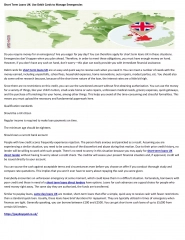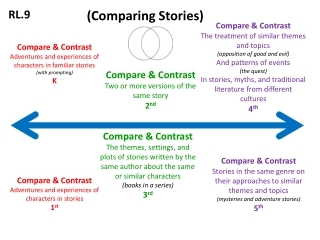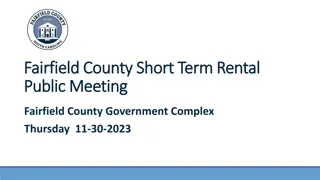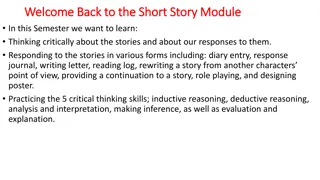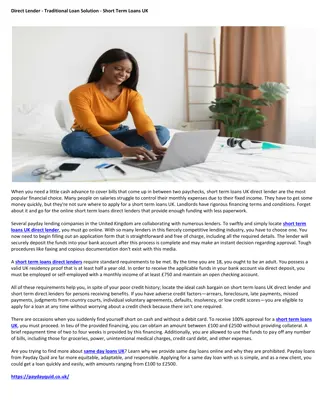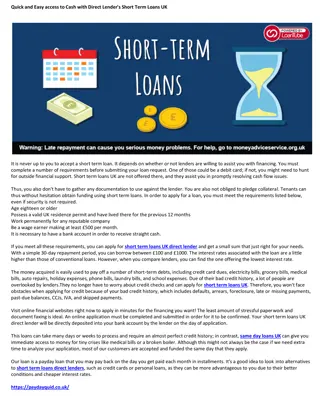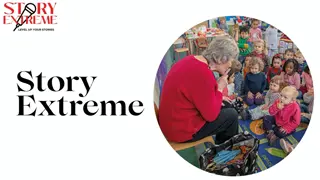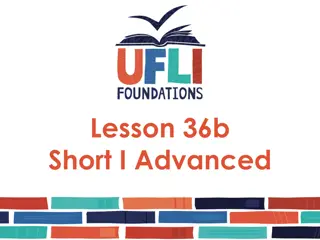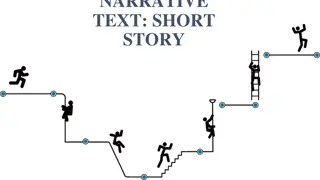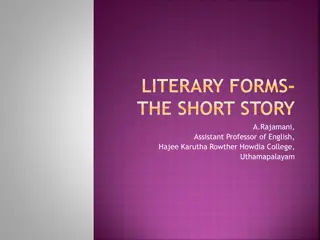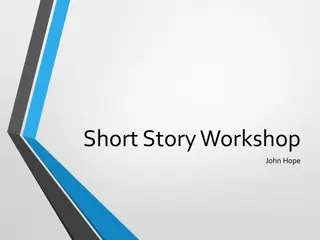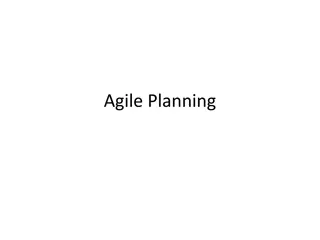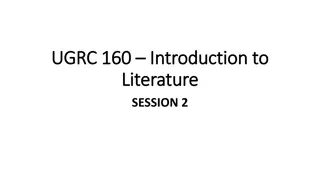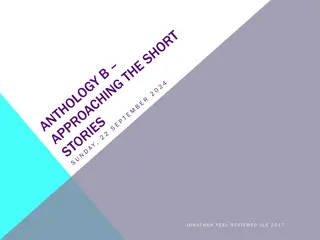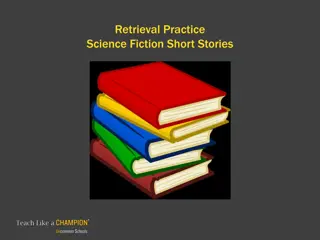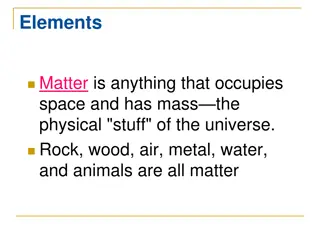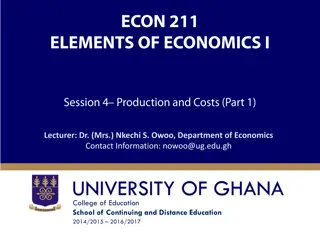Elements of Short Stories
Explore key components of short stories including characters, conflicts, genre, structure, and more. Learn about protagonists, antagonists, internal and external conflicts, different genres like historical and science fiction, and structural elements like flashbacks and parallel plots.
Download Presentation

Please find below an Image/Link to download the presentation.
The content on the website is provided AS IS for your information and personal use only. It may not be sold, licensed, or shared on other websites without obtaining consent from the author.If you encounter any issues during the download, it is possible that the publisher has removed the file from their server.
You are allowed to download the files provided on this website for personal or commercial use, subject to the condition that they are used lawfully. All files are the property of their respective owners.
The content on the website is provided AS IS for your information and personal use only. It may not be sold, licensed, or shared on other websites without obtaining consent from the author.
E N D
Presentation Transcript
Short Story Unit CHARACTERS AND CONFLICT
Elements of a Short Story Characters Protagonist: the main character Antagonist: the person or thing that opposes the main character, creating conflict Setting Time Hour, season, historical era Place General location, specific country, city, and any specific locations
Conflict: a struggle or problem characters face External: takes place between a character and an outside force (character, society, nature) Internal: struggle a character experiences between her own feelings, desires, or beliefs Plot Theme
Genre and Structure Genre: classification of literary works that share certain elements Realistic Believable characters facing true to life problems in a realistic setting Science Fiction Often set in the future in which actual or imagined science and technology play a central role
Historical Story set in the past that combines fictional characters with historical figures or events Humorous Comical characters and situations intended to amuse Parody An imitation of another story or writing style, intended to comment on or poke fun at the original
Genre and Structure Structure: the way in which events of the plot unfold and the reader learns about characters and situations Can be shaped by genre Ex: Mystery stories intriguing problem and a protagonist who seeks to solve it lots of plot twists and turns logical, but surprising resolution Chronological Order: events of the story are told in sequence from beginning to end
Flashbacks: interrupt the flow of chronological events to describe earlier events Provide insight into a character s past or motivations Parallel Plots: when author develops two distinct storylines, with two sets of characters, usually joining together into a single unified tale Pacing: speed or rhythm of the writing
Elements of Style Suspense: a feeling of anticipation that something risky or dangerous is about to happen Used to keep reader s interest and make reader more interested and sympathetic to the protagonist Author s create suspense by using Details and descriptions Onomatopoeia Unfamiliar settings Foreshadowing Irony
Elements of Style Irony: an effect created when a writer sets up a contrast between readers or characters expectations and reality May involve a difference between Appearance and reality Expectation and outcome Stated meaning and intended meaning Three types of Irony Situational: an event directly contradicts expectation Verbal: a character says the opposite of what she means Dramatic: the reader knows something the character does NOT Paradox: a statement that seems contradictory but reveals some deeper truth
IRONY OR PARADOX? I SEARCH EVERYWHERE FOR MY GLASSES, ONLY TO REALIZE I M WEARING THEM SITUATIONAL IRONY SOMEONE KNOCKS MY BOOKS OUT OF MY HAND IN THE HALLWAY, AND I SAY, THANKS. VERBAL IRONY JUMBO SHRIMP PARADOX
IRONY OR PARADOX? SOMEONE TELLS YOU THEY ARE A COMPULSIVE LIAR. PARADOX: A LIAR WOULDN T TELL THE TRUTH I M NOBODY. PARADOX A man looked out of the window to see the storm intensify. He turned to his friend and said wonderful weather we re having! VERBAL IRONY
IRONY OR PARADOX? Deep down, you're really shallow. PARADOX Being thirsty in the sea SITUATIONAL IRONY In Toy Story, human characters are not aware that the toys speak and move while the audience is aware DRAMATIC IRONY
Elements of Style Atmosphere: Refers to the emotions or feelings an author conveys through the descriptions of objects and setting Ex: JK Rowling s Harry Potter series whimsical and exciting It is an unspoken hunger we deflect with knives one avocado between us, cut neatly in half, twisted then separated from the large wooden pit. With the green fleshy boats in hand, we slice vertical strips from one end to the other. Vegetable planks. We smother the avocado with salsa, hot chiles at noon in the desert. We look at each other and smile, eating avocados with sharp silver blades, risking the blood of our tongues repeatedly. Here Terry creates a dangerous atmosphere where hazardous atmosphere is created as she presents knives and avocados. In fact, when an author tries to establish atmosphere by using objects, these objects represent unspoken reality. Besides, appearance of two characters also adds to a sexually charged atmosphere.
FORESHADOWING and FLASHBACK Foreshadowing: the use of details that hint at later events Not all foreshadowing is obvious. Frequently, future events are merely hinted at through dialogue, description, or the attitudes and reactions of the characters. Foreshadowing frequently serves two purposes. 1) It builds suspense by raising questions that encourage the reader to go on and find out more about the event that is being foreshadowed. 2) Foreshadowing is also a means of making a narrative more believable by partially preparing the reader for events which are to follow.
FLASHBACKS Flashback: a technique that involves a switch from present time of the narrative to a past time Come in the forms of Dreams Memories Sequences that interrupt stories of the past told by one character or an interruption by the author Flashback is useful for exposition, to fill in the reader about a character or place, or to explain the background to a conflict.
FLASHBACKS How to find a Flashback in literature Look for a place where the writer breaks up the chronological order of the plot to tell about something that took place earlier. Look for time words such as years ago, in the past, and then: Examples I thought about what had happened earlier.... Images from years ago flooded my brain.... A memory from the distant past surged up.....
FLASHBACKS How to find a Flashback in literature Look for dates, characters' ages, and words about youth or old age Examples When Carlita was nine, her father taught her to swim...... Before I became the old man you see before you...... Look for time words such as now, today, and these days. Such phrases can indicate the stopping point of a flashback. Examples: Now I am a grownup..... These days I live more slowly than when I was in the army.
IMAGERY AND CONFLICT Imagery: The use of vivid or figurative language to represent objects, actions, places, or ideas To create imagery, authors use Sensory Details Sensory Details are any detail that draws on any of the five senses. Sight Visual Imagery Sound Auditory Imagery Taste Gustatory Imagery Touch Tactile Imagery Smell Olfactory Imagery
IMAGERY PRACTICE WHICH SENSE DOES THE FOLLOWING IMAGE APPEAL TO? And straightway like a bell Came low and clear The slow, sad murmur of the distant seas, Hearing What type of imagery is this? Auditory Imagery
IMAGERY PRACTICE WHICH SENSE DOES THE FOLLOWING IMAGE APPEAL TO? And bubbling sea-weeds as the waters go Swish to and fro SIGHT WHAT TYPE OF IMAGERY IS THIS? VISUAL IMAGERY
IMAGERY PRACTICE WHICH SENSE DOES THE FOLLOWING IMAGE APPEAL TO? Their long, cold tentacles of slimy grey. WHAT SENSE DOES THIS APPEAL TO? COLD AND SLIMY TOUCH GREY TENTACLES VISUAL WHAT TYPES OF IMAGERY ARE THESE? TACTILE IMAGERY AND VISUAL IMAGERY
CONFLICT Without conflict, there is no plot! Introduced during the rising action Faced head-on during the climax Begins to work itself out during the falling action Is resolved during the resolution
CONFLICT Internal Character vs Him- or Herself Struggle takes place in character s own mind Usually something to do with choice or overcoming emotions or mixed feelings
CONFLICT External Character vs Character Protagonist vs antagonist Character vs Nature Usually character is struggling to survive Character vs Society Group of characters fighting against society Character fights against social traditions or rules
CONFLICT OTHER TYPES OF CONFLICT Character vs Supernatural Gods, ghosts, monsters, spirits, aliens, etc. Character vs Fate Fight for choice; fight against destiny Character vs Technology Computers, machines, etc.
CONFLICT MAN V. ? Nature
CONFLICT Man v. ? Charles decided to break all the rules the day he decided to steal that car. He was immediately arrested and sent to jail to await his trial. He should have known better than to mess with the rules. Man V. Society
CONFLICT Man V. ? I don t care who you talk to! screamed Sarah to West. I just wish I had never met you! Man v. Man
CONFLICT Man V. ? Tom found a dry spot to sit down in the dark and began to feel guilty over an argument he had had earlier in the day with his mother in which he had said, I hope I never see you again! Man v. Self


